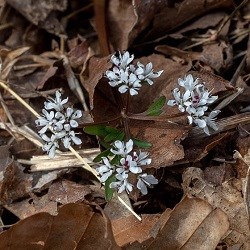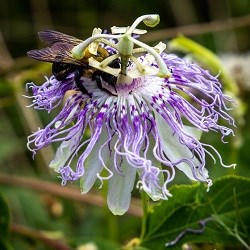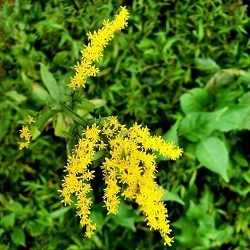|
One of the highlights of hiking the forests of Mammoth Cave National Park is the chance to view a wide variety of beautiful wildflowers. From the early spring days of March through the chilly afternoons of October, different wildflowers can be found across the park. Small clusters of harbingers-of-spring decorate the forest floor as the trees flourish back to life. The heat of summer brings with it a whole host of colors, from yellow prairie coneflowers, to pink blazing stars, and purple passionflowers. As the weather cools, delicate ladies’-tresses begin to bloom along with varied yellow hues of the many goldenrod species found in the park. 
NPS Photo/ Kait Evensen harbinger-of-spring Erigenia bulbosaThis tiny flowering plant gets its name for being one of the very first flowers to appear during the early days of March. The white flowers branch out in clusters from the top of the stem, displaying deep red anthers. Each plant has only a few divided and deeply lobed leaves. 
NPS Photo/ Kait Evensen passionflower Passiflora incarnataThe passionflower is an easily recognizable summer-blooming vine found around the park. Climbing tendrils can extend for over 25 feet, winding up vertical surfaces or simply creeping across the forest floor. Crimped, hair-like segments are backdropped by light purple petals with showy yellow stamens radiating from the central point of the flower. 
NPS Photo/ Rachel Kem goldenrod Solidago sp.With over 20 species of goldenrods found at Mammoth Cave, you don’t have to look far to spot these cheery yellow blooms. Stems lined with leaves ranging from thin and delicate to robust ovate (the wider part of the leaf is nearer to where it attaches to the stem) terminate in clusters of tiny yellow flowers. Recreating ResponsiblyWhen out recreating on your public lands, it is important to practice the 7 principals outline by Leave No Trace. Two of these principals can directly relate to preserving our wildflowers for future visitors to enjoy. Travel and Camp on Durable SurfacesWhen you are hiking, stay on the trail! The trails are designed to concentrate foot traffic to a small area. This minimizes our impact while allowing you to explore the surface ecosystems of our park. Many plants do not to do well if repeatedly trampled, so protect them by staying on trail. Leave What You FindPicking flowers not only deprives future visitors from appreciating the same bloom, but it could interfere with the plant’s only means of reproducing. While some flowers can spread from their roots, many do so with seeds that form after the flower wilts.
Take a hike!Explore Wildflowers at Cedar Sink |
Last updated: November 10, 2021
